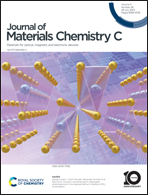Lattice matched GeSn/InAlAs heterostructure: role of Sn in energy band alignment, atomic layer diffusion and photoluminescence
Abstract
Germanium alloyed with α-tin (GeSn) transitions to a direct bandgap semiconductor of significance for optoelectronics. It is essential to localize the carriers within the active region for improving the quantum efficiency in a GeSn based laser. In this work, epitaxial GeSn heterostructure material systems were analyzed to determine the band offsets for carrier confinement: (i) a 0.53% compressively strained Ge0.97Sn0.03/AlAs; (ii) a 0.81% compressively strained Ge0.94Sn0.06/Ge; and (iii) a lattice matched Ge0.94Sn0.06/In0.12Al0.88As. The phonon modes in GeSn alloys were studied using Raman spectroscopy as a function of Sn composition, that showed Sn induced red shifts in wavenumbers of the Ge–Ge longitudinal optical phonon mode peaks. The material parameter b representing strain contribution to Raman shifts of a Ge0.94Sn0.06 alloy was determined as b = 314.81 ± 14 cm−1. Low temperature photoluminescence measurements were performed at 79 K to determine direct and indirect energy bandgaps of Eg,Γ = 0.72 eV and Eg,L = 0.66 eV for 0.81% compressively strained Ge0.94Sn0.06, and Eg,Γ = 0.73 eV and Eg,L = 0.68 eV for lattice matched Ge0.94Sn0.06 epilayers. Chemical effects of Sn atomic species were analyzed using X-ray photoelectron spectroscopy (XPS), revealing a shift in Ge 3d core level (CL) spectra towards the lower binding energy affecting the bonding environment. Large valence band offset of ΔEV = 0.91 ± 0.1 eV and conduction band offset of ΔEC,Γ–X = 0.64 ± 0.1 eV were determined from the Ge0.94Sn0.06/In0.12Al0.88As heterostructure using CL spectra by XPS measurements. The evaluated band offset was found to be of type-I configuration, needed for carrier confinement in a laser. In addition, these band offset values were compared with the first-principles-based calculated Ge/InAlAs band alignment, and it was found to have arsenic up-diffusion limited to 1 monolayer of epitaxial GeSn overlayer, ruling out the possibility of defects induced modification of band alignment. Furthermore, this lattice matched GeSn/InAlAs heterostructure band offset values were significantly higher than GeSn grown on group IV buffer/substrates. Therefore, a lattice matched GeSn/InAlAs material system has large band offsets offering superior carrier confinement to realize a highly efficient GeSn based photonic device.



 Please wait while we load your content...
Please wait while we load your content...
